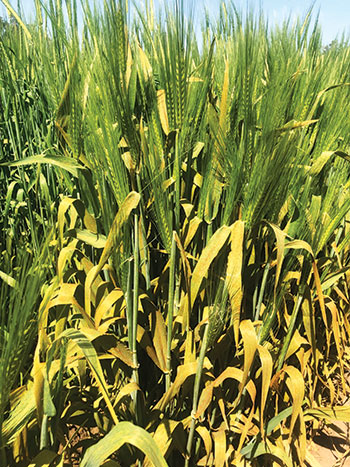A key to the success of pathogenic microbes in causing disease is the ability to generate genetic variation. The fungi that cause cereal diseases are no exception in this regard – new pathotypes (strains, races) arise from time to time due to random processes such as mutation.
The ability to infect a previously resistant cereal cultivar confers a strong selective advantage on a new pathotype, leading to it being selected for and its frequency increasing within the overall pathogen population.
The use of fungicides in Australian broadacre farming since the early 1980s has provided another selection pressure on fungal crop pathogens. The use of these chemicals has been followed by the emergence of insensitivity, especially to the demethylation inhibitor (DMI) fungicides, meaning that they are no longer as effective as a control option. This has been well-documented in, for example, Septoria tritici blotch, wheat powdery mildew, barley powdery mildew, and net form of net blotch and blackleg in canola.
Cases of fungicide insensitivity in rust pathogens are fortunately much less common. Apart from reports from Brazil of a decline in the field performance of DMIs against the Asian soybean rust pathogen, few – if any – agronomically significant cases of fungicide insensitivity in a rust pathogen are known.
 Severe leaf rust on barley, caused by Puccinia hordei.
Severe leaf rust on barley, caused by Puccinia hordei.
Using methods the Plant Breeding Institute developed to test fungicide sensitivity in rust pathogens, we screened more than 800 rust isolates of wheat (stem rust, leaf rust, stripe rust), barley (leaf rust) and oats (crown rust, stem rust) for sensitivity to the DMI fungicide tebuconazole.
Importantly, these tests revealed insensitivity in isolates of the barley leaf rust pathogen Puccinia hordei collected in 2020 to not only tebuconazole, but also prothioconazole, propiconazole and triadimenol.
We then ran the same tests on standard historical isolates of P. hordei from our rust collection and were able to show that the insensitivity occurs in a clonal lineage of pathotypes that trace back to an exotic incursion into Western Australia that was first detected in 2001.
All isolates within this lineage that we tested, including the original 2001 isolate, were insensitive to tebuconazole at rates of more than six times the recommended high field rate of 290 millilitres per hectare.
Further testing demonstrated insensitivity in several other pathotypes of P. hordei that are not members of the ‘insensitive’ lineage. We believe that these pathotypes probably originated from the alternate host Ornithogalum in South Australia, and that they were derived from isolates of the ‘insensitive’ lineage ‘breeding’ with other local sensitive isolates.
Our work appears to be the first documented case of insensitivity to a fungicide of field significance in a cereal-attacking rust pathogen. It yet again reminds us of the remarkable abilities of these pathogens to change and adapt to circumvent the strategies used to control them, be they genetic resistance or agricultural chemicals.
The ability to trace back the origin of this insensitivity to an exotic rust isolate that was first detected in Australia in 2001, and then translate the results to the broader Australian context, also highlights the importance of long-term nationwide monitoring of rusts.
As always, we encourage all stakeholders to inspect crops and nearby weeds for rust diseases. If rust is found, please send freshly collected samples in paper only to the Australian Cereal Rust Survey, University of Sydney, Australian Rust Survey, Reply Paid 88076, Narellan, New South Wales, 2567.
More information: Australian Cereal Rust Survey interactive map showing the distribution of rust pathotypes

























































